Novel Gradation Design of Porous Asphalt Concrete with Balanced Functional and Structural Performances
Abstract
1. Introduction
2. Materials and Test Methods
2.1. Material
2.1.1. Binder
2.1.2. Aggregate
2.1.3. Mineral Filler
2.1.4. Additives
2.2. Gradations
2.3. Optimum Asphalt Content
2.4. Mixture Performance Testing
2.4.1. Schellenberg Binder Draindown Test
2.4.2. Cantabro Abrasion Test
- Standard Cantabro test: specimens were tested after being immersed at 20 °C water for 20 h;
- Immersion Cantabro test: specimens were tested after being immersed at 60 °C water for one, two, and three days;
- Freeze–thaw Cantabro test: specimens were tested after one, two, and three freeze–thaw cycles. For the freeze–thaw condition, the immersed specimens are placed in a programmable high and low temperature test chamber, as shown in Figure 2. One cycle temperature condition is that the temperature in the chamber is at 60 °C for 12 h and then at −18 °C for 12 h.
2.4.3. Moisture Susceptibility Test
2.4.4. High-Temperature Permanent-Deformation Test
2.4.5. Low-Temperature Cracking Resistance Test
2.4.6. Permeability Test
3. Test Results and Discussion
3.1. Mix Design Properties
3.2. Moisture Susceptibility
3.3. Durability
3.4. High-Temperature Permanent Deformation
3.5. Low-Temperature Cracking Resistance
3.6. Permeability
3.7. Determination of Mineral Filler Content
4. Conclusions
- When the mineral filler content is increased, more asphalt binder is needed to form the asphalt mastic, which can improve the strength of PAC10 mixtures.
- Novel PAC10 (without 0.075–3 mm aggregate) with 6% mineral filler can have equivalent moisture susceptibility and durability compared with conventional PAC13.
- PAC13 showed better rutting resistance than the conventional PAC10, but the high-temperature stability of the novel PAC10 can be equivalent to or even better than PAC13 by increasing the mineral filler content.
- Conventional PAC10 showed better low-temperature cracking resistance than PAC13. The low-temperature performance of PAC10 is compromised when 0.075–3 mm aggregate is excluded, but it can be improved by increasing the mineral filler content.
- The permeability of the conventional PAC10 is obviously worse than PAC13, but excluding the 0.075–3 mm aggregate from PAC10 is effective in improving the permeability of PAC10.
- Six percent mineral filler is recommended for the novel gradation design to keep the balance of durability and functionality.
Author Contributions
Funding
Conflicts of Interest
References
- Takahashi, S. Comprehensive study on the porous asphalt effects on expressways in Japan: Based on field data analysis in the last decade. Road Mater. Pavement Des. 2013, 14, 239–255. [Google Scholar] [CrossRef]
- Hsu, T.-W.; Chen, S.-C.; Hung, K.-N. Performance Evaluation of Asphalt Rubber in Porous Asphalt-Concrete Mixtures. J. Mater. Civ. Eng. 2011, 23, 342–349. [Google Scholar] [CrossRef]
- Chen, J.-S.; Lee, C.-T.; Lin, Y.-Y. Influence of Engineering Properties of Porous Asphalt Concrete on Long-Term Performance. J. Mater. Civ. Eng. 2017, 29, 04016246. [Google Scholar] [CrossRef]
- Zhao, Y.; Zhu, Y.-T. Metals Leaching in Permeable Asphalt Pavement with Municipal Solid Waste Ash Aggregate. Water 2019, 11, 2186. [Google Scholar] [CrossRef]
- Zhu, Y.; Zhao, Y.; Zhao, C.; Gupta, R. Physicochemical characterization and heavy metals leaching potential of municipal solid waste incinerated bottom ash (MSWI-BA) when utilized in road construction. Environ. Sci. Pollut. Res. 2020, 1–14. [Google Scholar] [CrossRef] [PubMed]
- Liu, Y.; Cheng, X.; Yang, Z. Effect of Mixture Design Parameters of Stone Mastic Asphalt Pavement on Its Skid Resistance. Appl. Sci. 2019, 9, 5171. [Google Scholar] [CrossRef]
- Pérez-Acebo, H.; Gonzalo-Orden, H.; Findley, D.J.; Rojí, E. A skid resistance prediction model for an entire road network. Constr. Build. Mater. 2020, 262, 120041. [Google Scholar] [CrossRef]
- Mansour, T.N.; Putman, B.J. Influence of Aggregate Gradation on the Performance Properties of Porous Asphalt Mixtures. J. Mater. Civ. Eng. 2013, 25, 281–288. [Google Scholar] [CrossRef]
- Li, Q.; Zhang, Z.; Zhang, S. Performance Evaluation of Warm-Mix Recycled Asphalt Binders after Long-Term Aging. J. Test. Eval. 2019, 47, 2889–2904. [Google Scholar] [CrossRef]
- Ma, X.; Zhou, P.; Jiang, J.; Hu, X. High-temperature failure of porous asphalt mixture under wheel loading based on 2D air void structure analysis. Constr. Build. Mater. 2020, 252, 119051. [Google Scholar] [CrossRef]
- Nekkanti, H.; Putman, B.J.; Danish, B. Influence of Aggregate Gradation and Nominal Maximum Aggregate Size on the Performance Properties of OGFC Mixtures. Transp. Res. Rec. 2019, 2673, 240–245. [Google Scholar] [CrossRef]
- Ma, X.; Li, Q.; Cui, Y.-C.; Ni, A.-Q. Performance of porous asphalt mixture with various additives. Int. J. Pavement Eng. 2016, 19, 355–361. [Google Scholar] [CrossRef]
- Liu, Q.; Cao, D. Research on Material Composition and Performance of Porous Asphalt Pavement. J. Mater. Civ. Eng. 2009, 21, 135–140. [Google Scholar] [CrossRef]
- Takahashi, S.; Partl, M. Improvement of mix design for porous asphalt. Road Mater. Pavement Des. 2001, 2, 283–296. [Google Scholar] [CrossRef]
- Chen, M.J.; Wong, Y.D. Gradation design of porous asphalt mixture (PAM) for low-strength application in wet environment. Int. J. Pavement Eng. 2016, 19, 611–622. [Google Scholar] [CrossRef]
- Yu, B.; Jiao, L.; Ni, F.; Yang, J. Long-term field performance of porous asphalt pavement in China. Road Mater. Pavement Des. 2014, 16, 214–226. [Google Scholar] [CrossRef]
- Qian, Z.; Lu, Q. Design and laboratory evaluation of small particle porous epoxy asphalt surface mixture for roadway pavements. Constr. Build. Mater. 2015, 77, 110–116. [Google Scholar] [CrossRef]
- Ministry of Transport of the People’s Republic of China. JTJ E20-2011: Standard Test Methods of Bitumen and Bituminous Mixtures for Highway Engineering; Ministry of Transport of the People’s Republic of China: Beijing, China, 2011.
- Ministry of Transport of the People’s Republic of China. JTG F40–2004: Technical Specification for Construction of Highway Asphalt Pavement; Ministry of Transport of the People’s Republic of China: Beijing, China, 2004.
- Ministry of Transport of the People’s Republic of China. JTG E42-2005: Test Methods of Aggregate for Highway Engineering; Ministry of Transport of the People’s Republic of China: Beijing, China, 2005.
- South Carolina Department of Transportation. Supplemental Specification: Open Graded Friction Course; South Carolina Department of Transportation: Columbia, SC, USA, 2016.
- Leng, Z. The Design on the Gradation and Research on the Performance of the Porous Asphalt. Master’s Thesis, Southeast University, Nanjing, China, 2003. [Google Scholar]
- American Association to State Highway and Transportation Officials. AASHTO T 283: Resistance of Compacted HMA to Moisture-Induced Damage. Standard Specifications for Transportation Materials and Methods of Sampling and Testing; AASHTO: Washington, DC, USA, 2010. [Google Scholar]
- Ma, X.; Ni, F.; Wang, Y.; Chen, R. Test and analysis on permeability of porous asphalt mixture. J. Build. Mater. 2009, 12, 168–172. [Google Scholar]
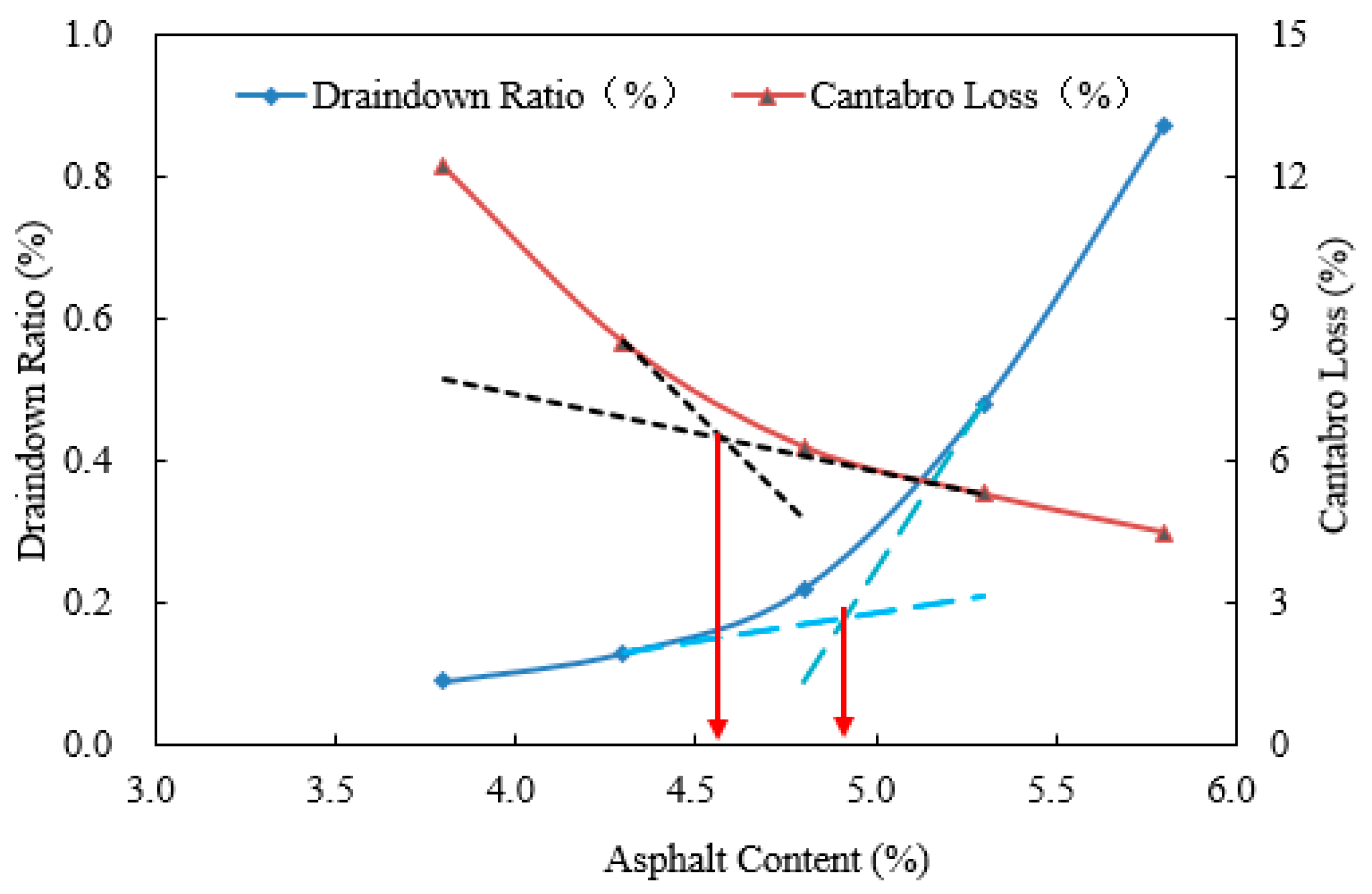
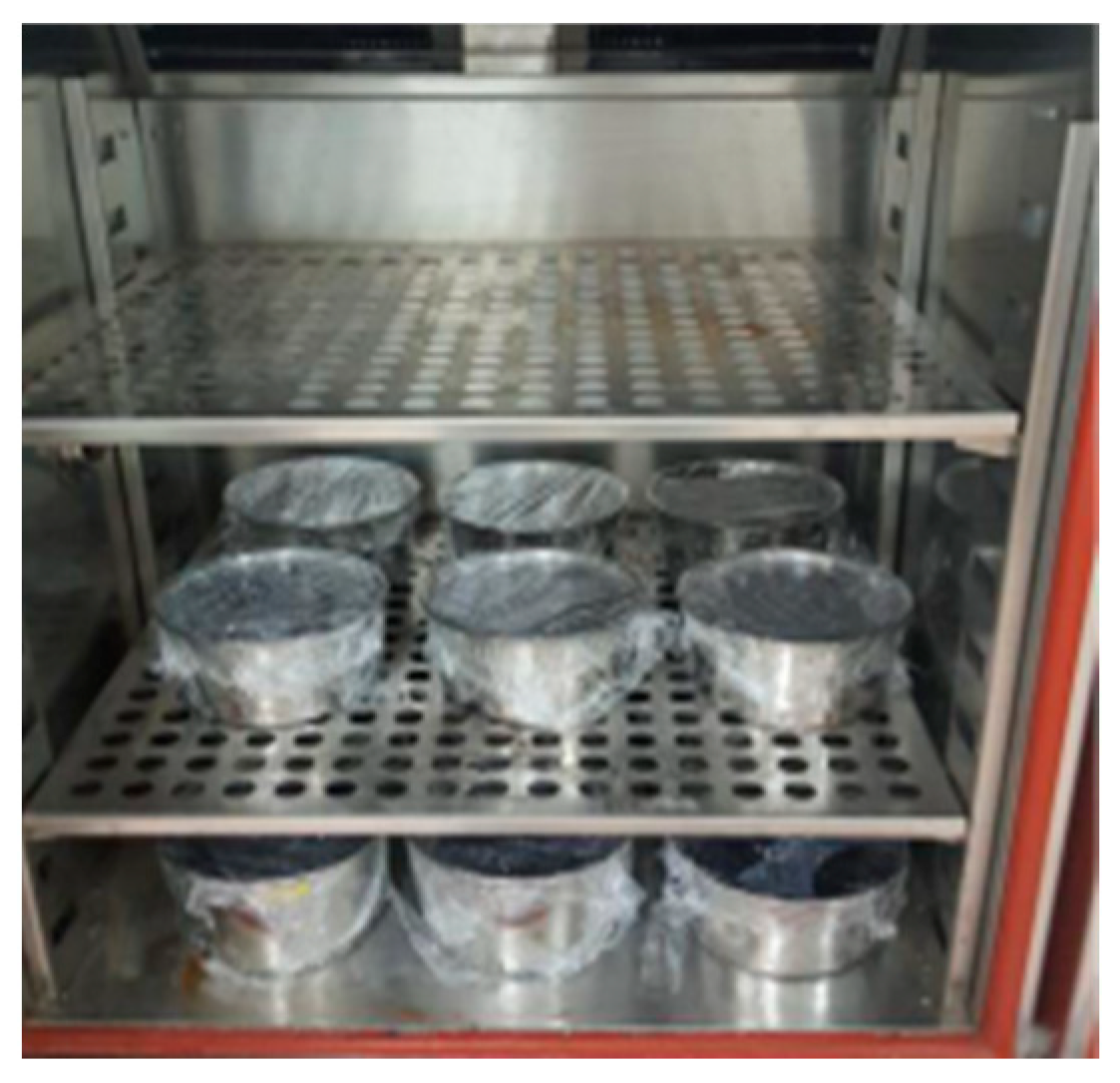
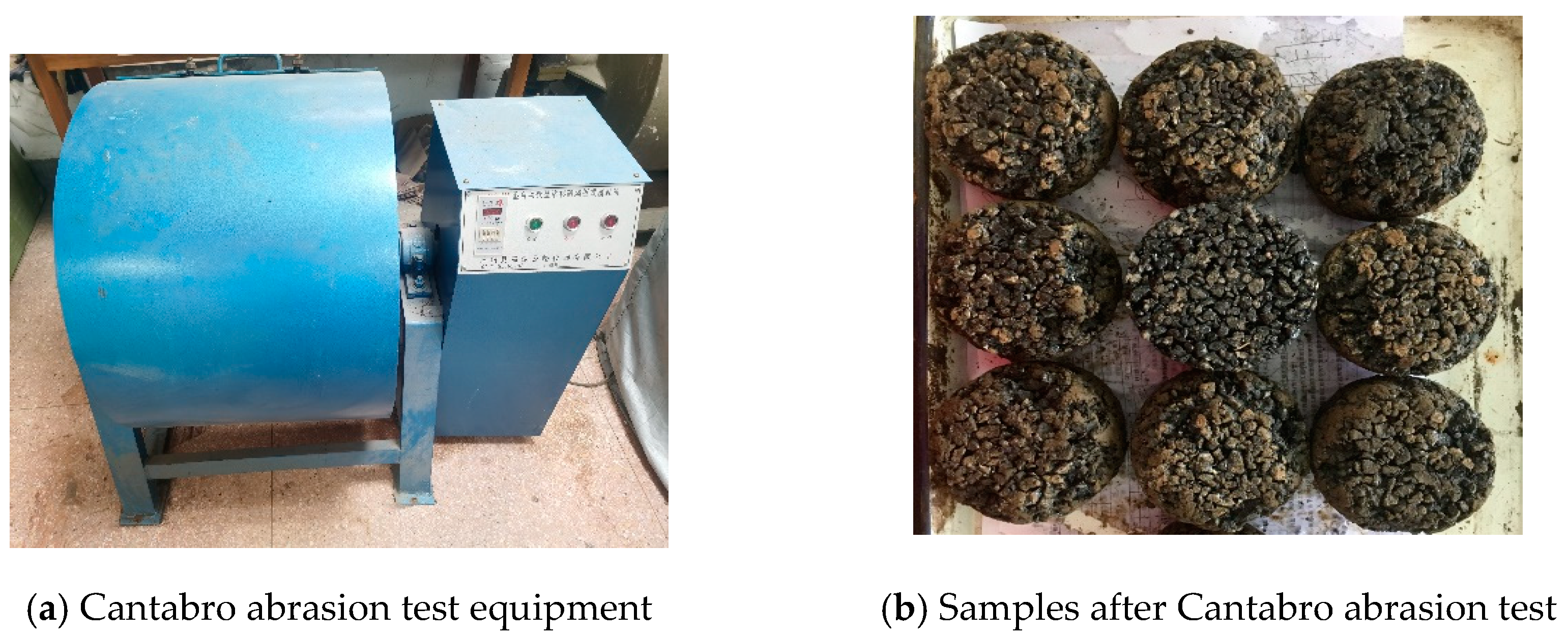


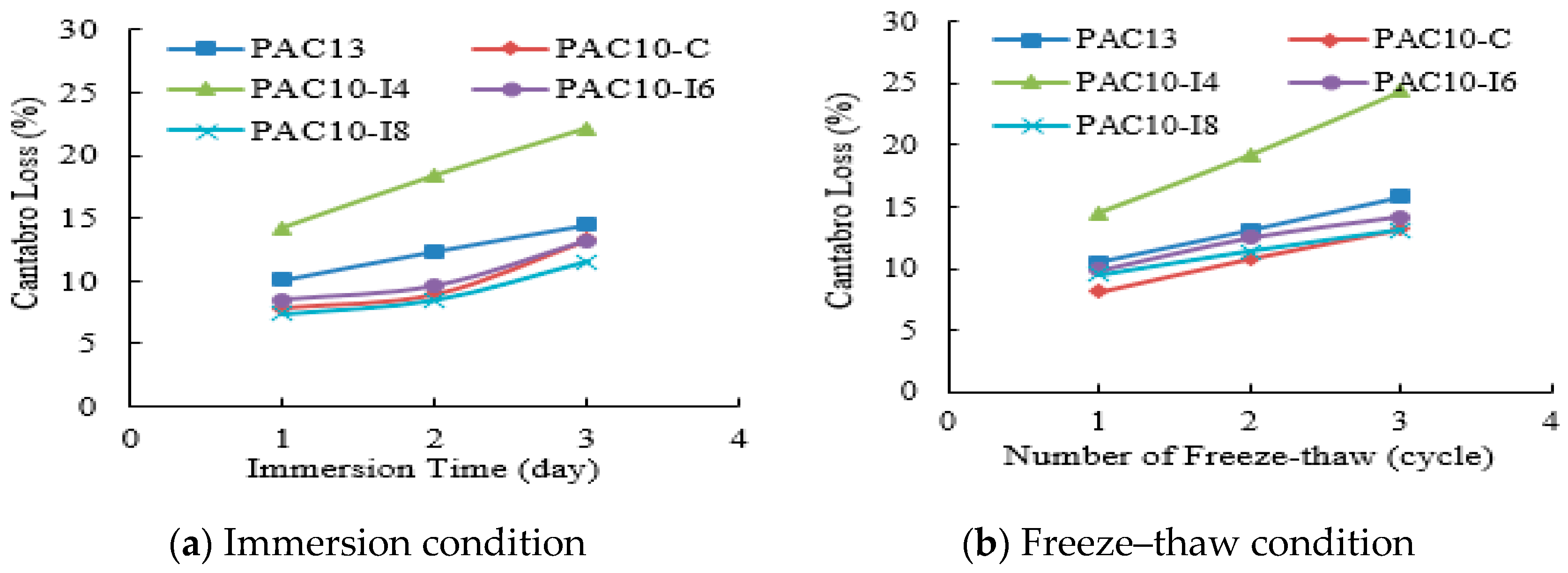

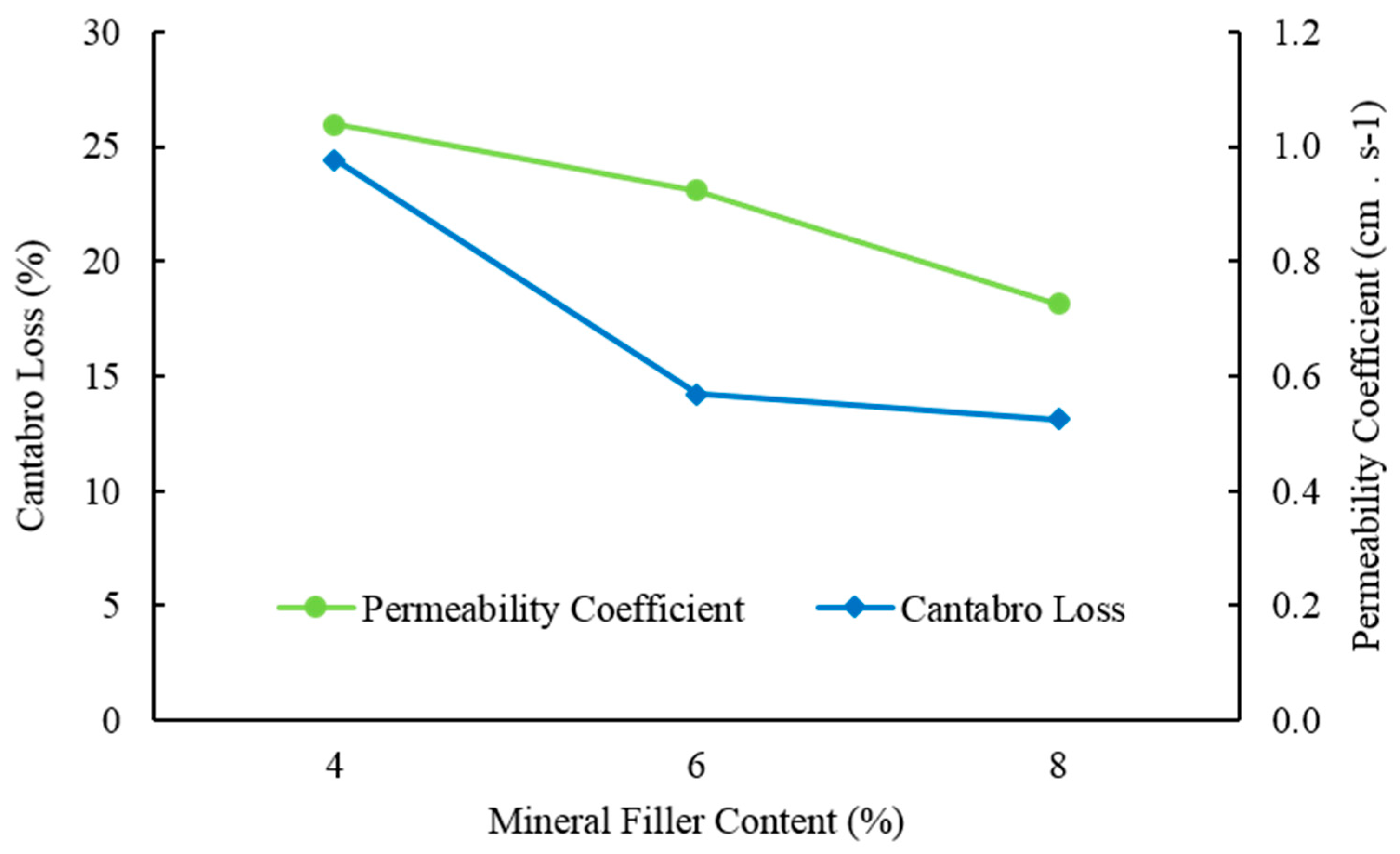
| Properties | Test Results | Specification Method [18] |
|---|---|---|
| Penetration (25 °C, 100 g, 5 s) (0.1 mm) | 53 | T 0604 |
| Ductility (5 °C, 5 cm/min) (mm) | 32 | T 0605 |
| Softening point (°C) | 84 | T 0606 |
| Viscosity (135 °C, Pa.s) | 2.35 | T 0625 |
| Kinetic viscosity (60 °C, Pa.s) | 15790 | T 0620 |
| Aggregate Types | Properties | Test Results | Technical Requirement [19] | Specification Method [20] |
|---|---|---|---|---|
| Coarse aggregate | Apparent specific gravity | 2.934 | ≥2.6 | T 0304 |
| LA abrasion (%) | 12.5 | ≤28 | T 0317 | |
| Crush value (%) | 11.4 | ≤26 | T 0316 | |
| Absorption (%) | 1.13 | ≤2.0 | T 0307 | |
| Fine aggregate | Apparent specific gravity | 2.853 | ≥2.5 | T 0328 |
| Sand equivalent value (%) | 71 | ≥60 | T 0334 |
| Properties | Test Results | Technical Requirement [19] | Specification Method [20] | |
|---|---|---|---|---|
| Apparent specific gravity | 2.726 | ≥2.5 | T 0352 | |
| Water content (%) | 0.24 | ≤1.0 | T 0352 | |
| Hydrophilic coefficient | 0.71 | <1.0 | T 0354 | |
| Gradation (% passing) | <0.6 mm | 100.0 | 100 | T0351 |
| <0.15 mm | 93.0 | 90−100 | ||
| <0.075 mm | 87.6 | 70−100 | ||
| Items | PAC13 | PAC10-C | PAC10-I4 | PAC10-I6 | PAC10-I8 | |
|---|---|---|---|---|---|---|
| Aggregate Composition (%) | 1# (10−15 mm) | 44 | 0 | 0 | 0 | 0 |
| 2# (5−10 mm) | 40 | 84 | 75 | 75 | 75 | |
| 3# (3−5 mm) | 0 | 0 | 21 | 19 | 17 | |
| 4# (0.075−3 mm) | 12 | 12 | 0 | 0 | 0 | |
| Mineral filler | 4 | 4 | 4 | 6 | 8 | |
| Percent Passing (%) | 16 mm | 100 | 100 | 100 | 100 | 100 |
| 13.2 mm | 91.0 | 100 | 100 | 100 | 100 | |
| 9.5 mm | 62.1 | 99.1 | 99.2 | 99.2 | 99.2 | |
| 4.75 mm | 21.4 | 27.1 | 32.0 | 32.3 | 32.5 | |
| 2.36 mm | 13.3 | 13.4 | 5.0 | 6.9 | 8.8 | |
| 1.18 mm | 10.1 | 10.1 | 4.2 | 6.2 | 8.2 | |
| 0.6 mm | 7.5 | 7.5 | 4.0 | 6.0 | 8.0 | |
| 0.3 mm | 5.8 | 5.8 | 4.0 | 6.0 | 8.0 | |
| 0.15 mm | 4.8 | 4.8 | 3.7 | 5.6 | 7.4 | |
| 0.075 mm | 3.9 | 3.9 | 3.3 | 4.9 | 6.5 | |
| Mixture Property | Type of PAC | Technical Requirement [22] | ||||
|---|---|---|---|---|---|---|
| PAC13 | PAC10-C | PAC10-I4 | PAC10-I6 | PAC10-I8 | ||
| OAC (%) | 4.7 | 5.0 | 4.8 | 5.3 | 5.5 | — |
| Air void content (%) | 20.5 | 19.6 | 21.9 | 20.9 | 20.2 | 18–25 |
| Marshall stability (kN) | 5.8 | 5.4 | 4.7 | 5.5 | 6.1 | Min. 3.5 |
| Marshall flow (0.1 mm) | 30.4 | 30.8 | 27.4 | 28.2 | 31.5 | 20–40 |
| Draindown ratio (%) | 0.17 | 0.18 | 0.18 | 0.14 | 0.22 | Max. 0.3 |
| Cantabro loss 1 (%) | 9.8 | 8.3 | 14.3 | 8.8 | 7.4 | Max. 20 |
| Mixtures | Rutting Depth at 45 min (mm) | Rutting Depth at 60 min (mm) | DS (mm−1) | |
|---|---|---|---|---|
| Average Value | COV 1 (%) | |||
| PAC13 | 1.642 | 1.739 | 6495 | 10.7 |
| PAC10-C | 1.821 | 1.943 | 5164 | 8.4 |
| PAC10-I4 | 2.035 | 2.172 | 4599 | 9.5 |
| PAC10-I6 | 1.679 | 1.786 | 5888 | 10.2 |
| PAC10-I8 | 1.424 | 1.519 | 6631 | 5.4 |
| Mixtures | Flexural Strength (MPa) | Flexural Strain at Failure (10−3) | Flexural Stiffness at Failure (MPa) | |||
|---|---|---|---|---|---|---|
| Average Value | COV (%) | Average Value | COV (%) | Average Value | COV (%) | |
| PAC13 | 7.02 | 8.4 | 2632 | 9.5 | 2667 | 10.2 |
| PAC10-C | 6.61 | 9.8 | 3419 | 7.8 | 1933 | 8.4 |
| PAC10-I4 | 5.73 | 8.5 | 2835 | 8.4 | 2022 | 7.1 |
| PAC10-I6 | 6.04 | 6.6 | 2940 | 7.2 | 2055 | 8.1 |
| PAC10-I8 | 6.57 | 6.9 | 3255 | 5.9 | 2017 | 7.3 |
© 2020 by the authors. Licensee MDPI, Basel, Switzerland. This article is an open access article distributed under the terms and conditions of the Creative Commons Attribution (CC BY) license (http://creativecommons.org/licenses/by/4.0/).
Share and Cite
Ma, X.; Wang, H.; Zhou, P. Novel Gradation Design of Porous Asphalt Concrete with Balanced Functional and Structural Performances. Appl. Sci. 2020, 10, 7019. https://doi.org/10.3390/app10207019
Ma X, Wang H, Zhou P. Novel Gradation Design of Porous Asphalt Concrete with Balanced Functional and Structural Performances. Applied Sciences. 2020; 10(20):7019. https://doi.org/10.3390/app10207019
Chicago/Turabian StyleMa, Xiang, Hao Wang, and Peisheng Zhou. 2020. "Novel Gradation Design of Porous Asphalt Concrete with Balanced Functional and Structural Performances" Applied Sciences 10, no. 20: 7019. https://doi.org/10.3390/app10207019
APA StyleMa, X., Wang, H., & Zhou, P. (2020). Novel Gradation Design of Porous Asphalt Concrete with Balanced Functional and Structural Performances. Applied Sciences, 10(20), 7019. https://doi.org/10.3390/app10207019





